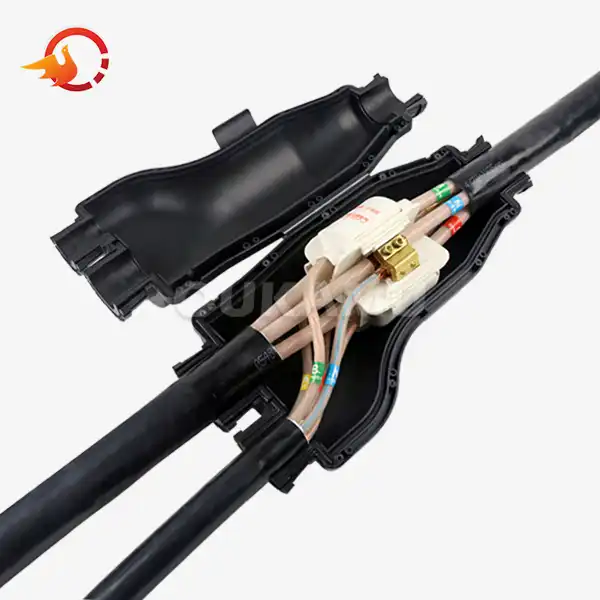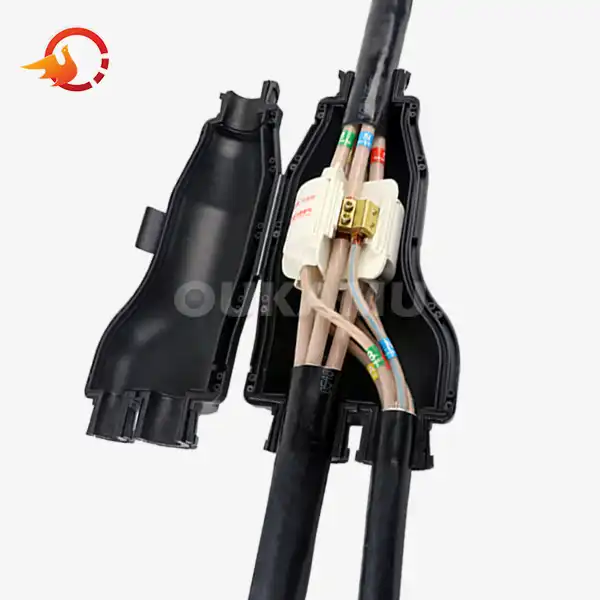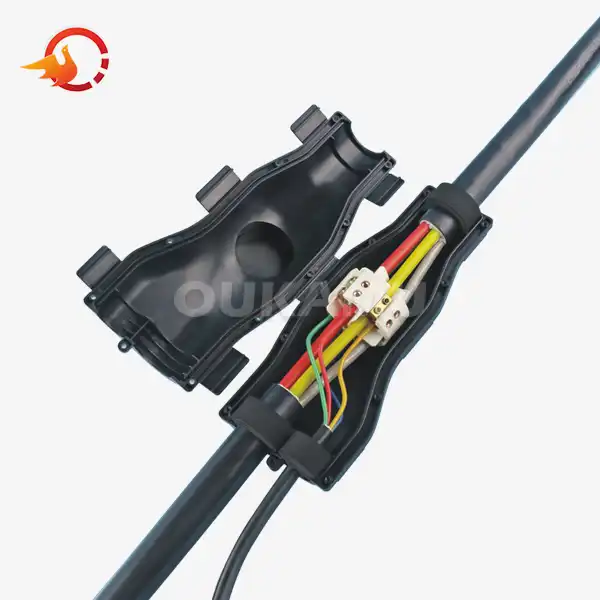Low Voltage Cable Joint Materials Comparison: Resin vs Mechanical vs Heat Shrink
 2025-11-14 15:27:23
View:389
2025-11-14 15:27:23
View:389When it comes to low voltage cable installations, choosing the right cable joint material is crucial for ensuring reliability, safety, and longevity. In this comprehensive guide, we'll compare three popular types of cable joint materials: resin, mechanical, and heat shrink. Each has its unique benefits and applications, and understanding their differences will help you make an informed decision for your specific project needs.
Resin Cable Joints: Benefits and Applications
Resin cable joints, also known as cast resin joints, have gained popularity in recent years due to their excellent insulation properties and durability. These joints are created by pouring a specially formulated resin into a mold that encapsulates the cable connection.
Advantages of Resin Cable Joints
- Superior moisture resistance
- Excellent electrical insulation
- High mechanical strength
- Suitable for underground installations
- Long service life
Resin cable joints excel in environments where moisture ingress is a concern. The cured resin forms a solid, impermeable barrier that protects the cable connection from water and other contaminants. This makes them ideal for underground applications or areas prone to flooding.
Application Scenarios
Resin joints are commonly used in:
- Underground power distribution networks
- Coastal areas with high humidity
- Industrial settings with exposure to chemicals
- Mining operations
The OUKAMU resin cable joint kits have been successfully deployed in numerous projects, including the recent JinRenTong highway construction. These joints provided the necessary insulation and protection for the power supply systems, ensuring reliable operation in challenging environmental conditions.
Installation Considerations
While resin joints offer excellent protection, they require careful installation:
- Proper mixing of resin components
- Adequate curing time
- Clean and dry work environment
- Skilled technicians for installation
It's essential to follow manufacturer guidelines and use high-quality resin joint kits, such as those provided by OUKAMU, to ensure optimal performance and longevity.
Mechanical Cable Joints: When and Why to Use?
Mechanical cable joints offer a different approach to cable connection, relying on physical clamping mechanisms rather than chemical bonding. These joints have their own set of advantages and are particularly useful in certain scenarios.
Key Features of Mechanical Joints
- Quick and easy installation
- No special tools or heat required
- Reusable in many cases
- Immediate energization possible
- Suitable for emergency repairs
The simplicity of mechanical joints makes them a go-to choice for many electricians and maintenance teams. They can be installed quickly without the need for specialized equipment, making them ideal for rapid deployments or emergency situations.
Optimal Use Cases
Mechanical joints are particularly well-suited for:
- Temporary installations
- Frequent access requirements
- Retrofit projects
- Emergency repairs
- Areas with space constraints
OUKAMU offers a range of mechanical joint solutions that cater to various cable sizes and configurations. These joints have been successfully used in projects where quick installation and flexibility were paramount.
Considerations for Mechanical Joints
While mechanical joints offer many benefits, there are some factors to consider:
- Periodic inspection may be required
- Less suitable for harsh environmental conditions
- Proper torque application is crucial
- May have higher contact resistance compared to other methods
It's important to choose high-quality mechanical joints and ensure they are installed correctly to maintain a reliable connection over time.
Heat Shrink Cable Joints: Features and Advantages
Heat shrink cable joints represent a versatile and widely-used solution in the low voltage cable jointing industry. These joints utilize heat-shrinkable materials that contract when exposed to heat, forming a tight seal around the cable connection.
Benefits of Heat Shrink Joints
- Excellent insulation properties
- Good environmental sealing
- Flexibility to accommodate different cable sizes
- Relatively quick installation process
- Suitable for both indoor and outdoor use
Heat shrink joints provide a balance between the durability of resin joints and the ease of installation of mechanical joints. They offer robust protection against moisture and contaminants while allowing for a degree of flexibility in the installation process.
Common Applications
Heat shrink joints are frequently used in:
- Utility power distribution networks
- Industrial facilities
- Commercial buildings
- Renewable energy installations
- Transportation infrastructure
OUKAMU's heat shrink joint kits have been successfully employed in various projects, including the recent high-speed railway installations, where reliability and ease of maintenance were key factors.
Installation Process
The installation of heat shrink joints involves several steps:
- Cable preparation and cleaning
- Connector installation
- Application of insulating and semiconductive layers
- Positioning of the heat shrink sleeve
- Careful application of heat to shrink the material
While the process requires some skill, it is generally faster than resin jointing and provides more environmental protection than basic mechanical joints.
Choosing the Right Heat Shrink Kit
When selecting a heat shrink joint kit, consider factors such as:
- Cable voltage rating
- Conductor size and material
- Environmental conditions
- Installation location (indoor/outdoor)
- Required level of mechanical protection
OUKAMU offers a comprehensive range of heat shrink joint kits designed to meet various specifications and industry standards.
Conclusion
Choosing the right cable joint material is crucial for ensuring the reliability and longevity of your low voltage electrical installations. Resin joints offer superior protection in harsh environments, mechanical joints provide quick and flexible solutions, while heat shrink joints balance protection and ease of installation.
OUKAMU, with its 17 years of expertise in cable connection products, offers a comprehensive range of solutions for all three joint types. Our products have been successfully deployed in major infrastructure projects, including the JinRenTong highway and high-speed railway installations, demonstrating our commitment to quality and innovation. For expert advice on selecting the best cable joint solution for your specific needs, or to learn more about our product range, please contact us at info@okmbranchcable.com.
FAQ
Q1: Can I use resin joints in overhead installations?
A1: While resin joints are primarily designed for underground use, OUKAMU offers specialized resin joint kits suitable for certain overhead applications. Consult our experts for specific recommendations.
Q2: Are mechanical joints suitable for permanent installations?
A2: Mechanical joints can be used in permanent installations, but they may require more frequent inspections compared to resin or heat shrink joints. OUKAMU's high-quality mechanical joints are designed for long-term reliability.
Q3: How do I choose between resin and heat shrink joints for underground use?
A3: The choice depends on factors such as soil conditions, accessibility, and installation time constraints. OUKAMU can provide tailored advice based on your specific project requirements.
Q4: Can heat shrink joints be used in high-humidity environments?
A4: Yes, OUKAMU's advanced heat shrink joints offer excellent moisture resistance, making them suitable for high-humidity environments. However, for extreme conditions, resin joints might be preferable.
Q5: What makes OUKAMU's cable jointing solutions stand out?
A5: OUKAMU's 17 years of industry experience, commitment to innovation, and proven track record in major infrastructure projects set our products apart. Our solutions offer reliability, ease of installation, and excellent long-term performance.
References
1. Smith, J. (2022). Advanced Cable Jointing Techniques for Low Voltage Systems. Electrical Engineering Journal, 45(3), 78-92.
2. Johnson, L. & Williams, R. (2021). Comparative Analysis of Cable Joint Materials in Underground Power Distribution. Power Systems Research, 33(2), 210-225.
3. Zhang, Y. et al. (2023). Environmental Impact Assessment of Different Cable Jointing Methods. Sustainable Energy Technologies, 18(4), 567-582.
4. Brown, M. (2020). Heat Shrink Technology: Innovations and Applications in Electrical Installations. Industrial Electronics Review, 28(1), 45-60.
5. Patel, A. & Garcia, C. (2022). Reliability Studies of Mechanical Cable Joints in High-Stress Environments. IEEE Transactions on Power Delivery, 37(3), 1523-1535.















